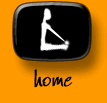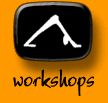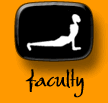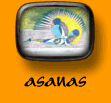

 |
 |
 |
 |
 |
 |
|
DOWNDOG | EAGLE | COBRA | HERO | HALF MOON | CORPSE | GATE
TRIANGLE | PEACOCK | LOCUST | COBBLER | SHOULDER STAND HEADSTAND | BRIDGE | CAMEL | COW FACE | UP BOW | INVERTED STAFF SEATED WIDE ANGLE | HEAD TO KNEE | TORTOISE | DANCER NOOSE  |
| Pincha Mayurasana ~ Peacock's Tail Feather Pose Therefore this asana is excellent for releasing tension in the shoulder girdle, opening the chest and strengthening the shoulders, upper arms and upper back. It also tones the abdominals, as it requires a lot of ab work (uddiyana bandha) to keep the ribs in and the lower back from arching. And it strengthens the legs and buttocks, because their muscles have to firmly contract and stretch upward as the tops of inner thighs squeeze together. Like all inversions, pincha mayurasana brings blood to the head and invigorates the entire body. When you learn to balance well in this exhilarating pose, you'll understand why peacocks like to strut their stuff. Images by Nancy Van Kanegan Because pincha mayurasana requires a good degree of both strength and flexibility in the shoulders, it's best to develop that before you try to launch your peacock tail. Otherwise you might collapse and strain them (or your ego). Therefore, you may find it helpful to take a phased approach to this asana. First, try a preparatory pose called elbow dog, so named because it's like downward facing dog pose adho mukha svanasana), but with your elbows on the mat. To do elbow dog, come to your hands and knees, with the wrists underneath the shoulders, the knees hips-width beneath the hip joints and the toes curled under. Lower the elbows down and turn the palms up to ground the outside of the elbows. Then turn the palms down, making sure the forearms are parallel, the fingers spread, and the palms, forearms and outer elbows pressing down. Look forward just past your hands and pull the abs in and up. With an inhale, push into the elbows, forearms and hands, lift the hips up and push them back with the legs strong. Take the upper back in and the shoulder blades together as you push your heart back while stretching the spine up and keeping the ribs in. Hold for 5-8 breaths and release. Then try this pose again, seeing if you can hold it longer - maybe 10-12 breaths (roughly a minute). If you can hold a straight line from your elbows through your shoulders to your tail in elbow dog for a minute (ask a friend to check your alignment or have a mirror on one side), you're ready to try the next phase - otherwise, keep working on elbow dog. (Because this next preparation and the full pose are more intense inversions, they are not advised if you have high blood pressure, heart problems, glaucoma detached retina, or you are menstruating.) You'll need a solid wall for this phase. To find where to place your elbows, sit for a moment facing the wall and adjust your position until your feet are against the wall with your legs extended straight ahead. Note where your sitting bones are - that's where you want your elbows to be. Now, facing away from the wall, come to your hands and knees and lower your elbows to the spot where your sitting bones were. Position the arms the same as you did for elbow dog, pull in your abs in and up, lift the hips, then walk the feet up the wall until the legs are parallel to the floor. Push into the hands, forearms and elbows and lift the hips up as you try to take your chest to the wall but keep the ribs back. Wow, strong stretch! Hold for a few breaths, bring the feet down, and rest in child's pose for a bit. If you're feeling ready to try elbow stand, you can move to the next phase. You'll use the wall again. There are a couple ways to do this. I'll first describe the more common method, then the one recommended by Donna Farhi, which I think is better for learning the correct alignment (see her book, Yoga Mind, Body & Spirit). Try each and see which you prefer. The typical way is to come to all fours facing the wall, and place your hands shoulder-width apart with the fingers spread and the tips of the middle fingers touching the wall. Turn the palms up to ground the outer elbow. Check to see that the forearms are parallel and grounded, the palms and fingertips are pressed down, the shoulder blades are on the back, the abs are pulling in and up, and the shoulders are lifting toward the hips. Arch the neck a bit and look at the wall. Lift the hips into elbow dog, walk the feet in toward the wall, and bend one knee. The bent leg is your pusher or springer, and the other leg, which stays straight and strong, is your lifter or swinger. Bend the knee a little more, and with an inhale push off with the bent leg as you swing the straight leg up and toward the wall, following immediately with a straightened left leg. Be careful not to swing up too vigorously, or you may damage the wall (or hurt your foot). If you're new at this, first try a couple of easy test springs and swings to get the timing and gauge the amount of energy you'll need to get up without crashing into the wall. Once you have the legs up against the wall bring the upper back and the sacrum in, the ribs back, and push down into the elbows, hands and forearms as you squeeze the legs together and stretch them strongly up. Vigorously lift the shoulders and hips while you keep your tailbone stretching up and in. Hold for 3-5 breaths at first, then lower the legs one at a time and come down. If your shoulders splayed out, you may have slid the hands toward each other, rolled to the inner part of your elbows, collapsed the shoulders inward and pulled the shoulder blades off your back. To avoid this, keep your weight on the outer edge of the forearms and elbows and keep opening the shoulders back. If you're still splaying out, it helps to place a block between the hands, with the thumbs in front and the index fingers along the sides, to keep the hands apart. Also, use a strap around the upper arms just above the elbows to keep them shoulder-width apart. If this is too intense, or you can't keep the forearms down, you might want to work more on the preparatory phases Ideally, in pincha mayurasansa the elbows, shoulders, hips and heels are all in the same vertical line. That's hard to do with the legs extended and the feet against the wall because the heels will be behind the hips. This makes it difficult to engage the abdominals and keep the torso in line. Therefore Donna Farhi recommends placing the elbows a shin's length away from the wall (you can measure it by kneeling with your feet against the wall and see where your knees are; then, when you face forward to lift up, your elbows should go where your knees were). When you're well positioned and aligned as described above, swing the legs up as in the previous version, but then slide both feet down the wall to where your shins are perpendicular to it. This will enable you to use your abdominal, pelvic and hamstring muscles to bring the pelvis away from the wall and into an upright position, with the knees, hips, shoulders and elbows all aligned. To do this, lift the tailbone actively, contract the abs and bring the pubic bone toward the navel to bring the ribs back and lengthen the spine. Keep the forearms grounded. If your alignment is good, you can try taking one leg straight up. If the balance and energy are there, you can then stretch the other up, too, squeezing the tops of the inner thighs together. After about 5 breaths, come down as in the other version. Gradually increase the length of time you stay in the pose, working on your balance and alignment. Of course, you'll eventually want - and be able - to do pincha mayurasana in the middle of the floor, kicking up one leg after the other. Then like a peacock you'll definitely have something to strut about. Text by Tim
Noworyta |
||
|
E-mail: info@yogamind.com | Return Home :: mindfully designed by braddon.com :: |